Slovak Opal: A New Life for a Historical Gem

Slovakia, a landlocked country in Central Europe, covers an area of 49,000 km² and has a population of 5.4 million. Its terrain is mostly mountainous, especially in the north and central regions, while the remaining areas are more or less flat with occasional hills that break through the landscape. Slovakia is a small country but rich in mineral resources. These resources were exploited extensively in the past, when present-day Slovakia was part of the Kingdom of Hungary. Since 1918, when this multiethnic kingdom collapsed and Slovakia transitioned to Czechoslovakia and later became an independent state in 1993, the Slovakian mining industry has changed significantly. Depleted mineral sources have been abandoned and new ones discovered and developed. Some localities that were once active and then vacated have seen attempts at revival. That is exactly the case with opal from the Slovakian village of Červenica-Dubník (figure 1).
Due to the geopolitical situation in the past, opal from this source was once known as Hungarian opal. Mining efforts expanded dramatically over the course of the nineteenth century, when there was private entrepreneurship in the locality. The “golden era” of 1845–1880 saw opal mines leased to the Goldschmidt family. Starting on November 1, 1896, gem mining was carried out by the state, which owned the deposits. Unfortunately, the state did not send the extracted stones to the market but to the treasury of the Ministry of Finance in Budapest (Butkovič, 1970). During that same period, the bountiful Australian deposits emerged as a formidable competitor to Hungarian opal (Cram, 1998). After World War I, Czechoslovakia could not afford to continue mining operations, which ceased in 1922. Today, these formerly Hungarian opals—now considered Slovak—are poised to regain their popularity.
SOURCE LOCATION
The opal region is situated in eastern Slovakia, in the Prešov region, largely in the Prešov district and the Červenica and Zlatá Baňa villages (figure 2). The area is accessible by vehicle on local road no. 3440 connecting the city of Prešov and the village of Rozhanovce, which is near the city of Košice.

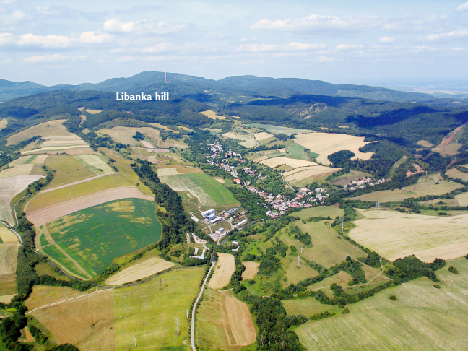
Whether starting in Prešov or Košice, the drive across the rural area is over slightly hilly terrain. The scenery eventually turns into the Slanské vrchy Mountains. From Prešov, one can admire a picturesque caldera (cauldron-like hollow) where Zlatá Baňa was founded in connection with exploration and subsequent small-scale, intermittent mining focused on antimony ore (stibnite) as well as polymetallic ores containing silver and gold. Starting from Košice, the traveler will not miss the Červenica village, which remains most associated with opal (figure 3) even though it likely had its beginnings with cinnabar mining circa 1400. Nevertheless, opal took the lead during the sixteenth century and made the place widely known.

The historical and prospective opal region extends several kilometers north-northeast from Červenica. The nearly defunct settlement of Dubník, which once served as lodging for the high-ranking staff of the opal mining enterprise, was a thriving place throughout the nineteenth century. It also housed an opal cutting workshop. Mining was carried out in various locations within and around the settlement. The most productive of the mines until the end of operations in 1922 (Butkovič, 1970) was located at Libanka Hill (figure 4). An operational center consisting of buildings for residential, industrial, and administrative purposes once stood on the eastern foothills, though time and development have removed the evidence. Recent activities are focused on this area and will be discussed further in this field report.
GEOLOGY AND MINERALOGY
Based on the geological environment, experts differentiate between “sedimentary-type” opal (found in numerous Australian deposits within the Great Artesian Basin) and “volcanic-type” opal (located around Tintenbar in New South Wales in Australia, as well as additional localities in the United States, Mexico, Honduras, Ethiopia, and Indonesia, among others) (Rondeau et al., 2004). Nevertheless, it is sometimes difficult to decide which “opal type” a specific site belongs to. At the Boi Morto mine in Brazil, for instance, opal can be found in both volcanic and sedimentary rocks (Farrar, 2007). Červenica-Dubník is also peculiar but in another respect. Rondeau et al. (2004) reported that opal from this locality shows all the physical properties typical of a “sedimentary-type” deposit but is found in a volcanic host rock (andesite). Some recent research has led to similar conclusions (Semrád, 2017). However, the genesis of precious opal is quite complex and beyond the scope of this report.
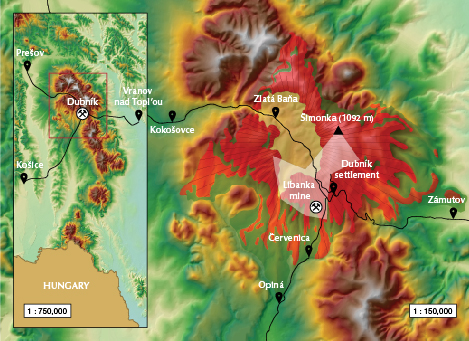
As previously mentioned, the home of Slovak opal is the Slanské vrchy Mountains, where the host environment for opal mineralization is of volcanic origin. This volcanic mountain range is approximately 10–14 million years old (Lower Pannonian to Upper Badenian, respectively) (Kaličiak and Repčok, 1987). The main segment running north to south bends slightly toward the east and consists of large adjacent relics of stratovolcanic structures: the Zlatá Baňa, Makovica, Strechový vrch, Bogota, and Veľký Milič stratovolcanoes. The range is 50 km long and varies in width from 20 km in the north to 12 km in the south. The Červenica-Dubník opal deposits are situated in the northern part of the mountains, specifically in the southeastern section of the Zlatá Baňa stratovolcano transitional zone (figure 5).

The geology of the deposits comprises four distinct lithologies. They differ in spatial orientation, and thus in age, as well as in petrographic composition (Kaličiak et al., 1976): two-pyroxene andesite (“Libanka” type), pyroxene andesite (“Ošvárska” type), pyroxene-amphibole andesite, and pyroxene-amphibole-biotite andesite. The old opal mining fields are situated close to two major tectonic zones of a northwest-southeast direction where petrographic varieties of andesite and their pyroclastics converge (figure 6). This suggests that lithological-petrographic and structural-tectonic “traps” played an essential role in the formation and distribution of opal mineralization (Kaličiak and Jacko, 1995). Major tectonic structures of a northwest-southeast direction are accompanied by minor pinnated and possibly parallel (synthetic) faults, shrinkage cracks, and cavities. These features and their surroundings are potential hosts for accumulations of opal. The highest opal concentrations were found and mined at fault intersections (Kaličiak et al., 1976).


In terms of mineralogy, the Červenica-Dubník opal deposits contain mostly opal and sulfides. The former comprises a few macroscopically distinct varieties of AG-opal (specifically precious opal, glassy opal, and milky opal; figures 7 and 8) and AN-opal (hyalite). X-ray diffraction analysis sometimes reveals minor admixtures of CT-opal, however (Semrád, 2017). The most abundant of the sulfides is iron disulfide, including both pyrite and marcasite (Slavík, 1920). Besides these two species, stibnite is also found in the deposits, though much less frequently. Interestingly, the Natural History Museum in London has one specimen from the locality that features precious opal and macroscopic flecks of native gold (Semrád, 2022a,b). Some clay minerals are also present in these deposits. Visitors touring the old mining works with a guide can marvel at places where walls and ceilings are covered with secondary sulfates.
RECENT DEVELOPMENTS
Because the Libanka mine was the largest and most bountiful in the area, it is not surprising that subsequent prospectors decided to continue mining activities in this region. During the peak decades (from the 1840s through the 1880s), this mine likely yielded tens of thousands of carats of cut precious opal annually. More accurate production data is available only from 1880 (tables 1 and 2). At the time the mining ceased, it was suggested that the future of opal from the Červenica-Dubník locality was not a question of reserves and production but one of sales (Slavík, 1920). Unfortunately, no one stepped forward during the interwar period to resume operations, and World War II further hampered the possibility.


Post-war Czechoslovakia saw exclusive state ownership of enterprises, and the economy was centrally managed. This meant that only the state could breathe life into the abandoned mines at Dubník. Mineral resources were surveyed (including the cinnabar deposit at nearby Libanka Hill) and extracted on a large scale in various localities. Economic planners, however, gave preference to industrially attractive commodities such as ores for the production of iron, copper, manganese, magnesium, and antimony, as well as coal and salt. Only when the transition from communism to democracy and a free-market economy brought private entities back to the stage during the late 1980s and early 1990s was there a chance to revive the opal mining operation.

Between 1991 and 2001, the companies Jozef Jančok - SAVARNA and Slovenský opál Ltd, surveyed all historical mining sites and adjacent areas with the hope of finding new opal-bearing structures (Jančok, 2001; table 3). Since October 2000, following the survey, Slovenský opál Ltd has held the Červenica mining claim, which overlaps considerably with the Libanka mining field from the past. On the basis of a preliminary agreement with an investor, the company Opálové bane Dubník JSC (Joint Stock Company) was founded in 2001. Subsequently, Slovenský opál Ltd applied to the regional mining authority to transfer the claim to Opálové bane Dubník JSC. This never materialized, however. A call aimed at regranting the claim was launched instead.
ObaB Ltd held the Červenica mining claim from September 2005 until July 2007, when it was transferred onto Opálové bane a brusiarne Ltd and in June 2010 further onto Opálové bane Libanka Ltd. Actual mining activity did not take place until 2012, however, and has since been intermittent. Finally, a new commercial name for opal from this area was introduced to sever any historical promotional ties. On October 11, 2016, the certified geographic designation “Slovak Opal” was registered with the Industrial Property Office of the Slovak Republic (Opálové bane Libanka Ltd, 2016). On November 10, 2016, it was subsequently registered with the International System of Appellations of Origin and Geographical Indications (Opálové bane Libanka Ltd, 2017). In accordance with the national and international registrations, the “Slovak Opal” designation is applicable exclusively to precious opal originating from the Červenica I protected deposit area (approximately 11 km2) and the Červenica mining claim (approximately 1 km2) (State Geological Institute of Dionýz Štúr, n.d.).
Currently, the Červenica claim is held by Slovenské opálové bane Ltd, the successor to Opálové bane Libanka Ltd since November 2021. Considerable time has passed since 2001, when Jozef Jančok provided the most recent calculation of opal reserves and resources. To gain up-to-date insight into the current production chain, the author interviewed Maroš Turek and Igor Kromka, executive directors of Slovenské opálové bane Ltd and Great Rent JSC, respectively.
OPAL EXTRACTION
Recent production relies exclusively on collecting and extracting the raw material from secondary deposits, specifically anthropogenic deposits. These include heaps of opal-bearing rock on the surface and underground backfilling in stopes (figures 9 and 10). According to Jančok (2001), the yield from these sources is substantial. In fact, opal miners left behind a considerable amount of gemmy material as they worked under challenging conditions. First was the poor lighting at underground excavation sites, with the use of very simple lighting tools. Second, the opal mineralization within the host rock environment occurred extremely irregularly in the form of either clusters or dendritic nests, veinlets or veins, breccia “cement,” and impregnations. Third, the presence of sticky clay from decomposed andesite, as well as hydrated iron oxide-hydroxides (possibly iron-oxyhydroxysulfate) from decomposed iron disulfide, made it difficult to spot gems. Nevertheless, it is still possible to find some modest opal specimens without picking through old rubble for hours (figure 11).


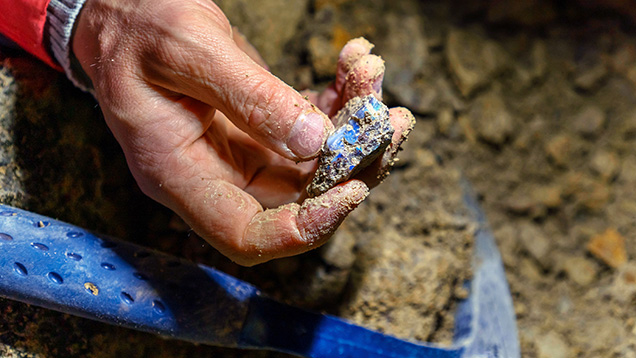
Larger pieces, unfortunately, are rarely found today. No wonder: Miners in the old days, despite all the aforementioned difficulties, did their best to extract as many “opal chunkies” as possible. Even when they failed, there was still a chance that unnoticed gems would be retrieved. Coincidentally, the author recently heard a story from a descendant living in the United States whose ancestors, a husband and wife, both worked in the opal mines at Červenica-Dubník. According to family recollections, the husband’s daily task was to search for the gems underground while his wife sifted through the material brought up to the surface. During this activity, she once managed to find a very large piece of opal (L. Lane, pers. comm., 2022).


Anyone searching for opal today must have permission from Slovenské opálové bane Ltd and use only hand tools. The company obtains its raw material in the same way because of the Červenica mining claim’s overlap with the Dubnícke bane Protected Site, declared in accordance with the SRNC (Slovak Republic National Council) Nature and Landscape Protection Act, and the Dubnícke bane Special Area of Conservation designated by the European Union’s Habitats Directive, also known as the Directive on the Conservation of Natural Habitats and of Wild Fauna and Flora (Štátna ochrana prírody Slovenskej republiky, n.d.; figure 12). Under the circumstances, any mechanized underground mining in this locality would very likely be rejected. As reported by Turek, the company’s priority is maintaining the safety of the old mining works for organized guided tours (figure 13). While finding opals during maintenance is considered a bonus, Turek noted that company workers sometimes look for them intentionally.
On the surface, the most promising place for opal reserves is the heap at the Viliam drainage adit. Besides casually picking through the excavated material by hand and possibly with hand tools, systematic and even to some extent mechanized mining would be feasible here, as it lies beyond the boundaries of the Dubnícke bane Protected Site. Knowing that this heap area is permitted by the regional mining authority for opal extraction until at least December 2030 (with the possibility of extension to December 2045), the author asked Turek whether they planned to start mining. He sounded somewhat skeptical and expressed doubt about the economic benefits compared to the project’s costs.
SORTING, CUTTING, AND FINISHING
For the first step of the production chain at Slovenské opálové bane Ltd, all the material obtained is thoroughly rinsed. The second step entails the separation of potential mineralogical specimens from potential rough material for cutting. The latter is sifted through a series of sieves (25, 20, 14, 10, 5, 4, and 2 mm2). During the third stage, both potential mineralogical specimens and rough material for cutting undergo a “stabilizing process,” as Turek called it. In this process, the material is deposited for a specific period under controlled temperature and humidity (further details were not disclosed). Given the description provided, it would be more accurate to call this a test of structural integrity under changing conditions. The material that does not pass the “stabilizing” process—meaning it has degraded considerably due to cracking, crazing, or loss of water—is excluded from further processing.
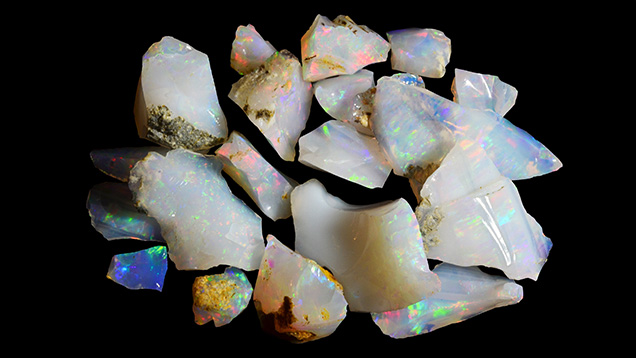

The mineralogical specimens that do pass are prepared for sale without any further treatment. The “stabilized” rough for cutting is sorted by hand. This process includes separation of precious opal (figure 14) as well as a highly transparent variety of common opal known as glassy opal (figure 15) from other varieties such as hazy glassy opal, milky opal, and hydrophane. The vast majority of the material is sold to Great Rent JSC, which purchases nearly all of the mineralogical specimens containing precious opal as well as compact pieces of precious opal and high-quality glassy opal for cutting purposes. The low-quality material that remains with Slovenské opálové bane Ltd is sold at the locality in the form of various souvenirs.

Great Rent JSC markets and sells Slovak Opal under the trademark Yophine. Kromka explained that the name is an allusion to Joséphine de Beauharnais, who possessed a beautiful opal parure given to her by Napoleon Bonaparte. Kromka added that the mineralogical specimens are first registered, with a unique identifier assigned and a specimen “passport” issued before being offered for sale. The opal pieces intended for cutting undergo an additional stabilizing process that is very similar to the previous one and again serves as a test of structural integrity. If an opal piece passes this test, a temporary identifier is assigned and it is either sent directly to a cutter or put in inventory (figure 16). Any piece that does not pass this process is returned to Slovenské opálové bane Ltd for reimbursement.
Most of the Červenica-Dubník precious opal, commercially known as Slovak Opal, can be classified as light opal (with a white and translucent to opaque body) or crystal opal (with a colorless, transparent body). Precious opal with a chromatic body hue, specifically within a range of yellow to orange to brown, occur rarely and are showcased as historical specimens in galleries at the Natural History Museum in Vienna, the Victoria and Albert Museum in London, and the Natural History Museum in London (Semrád, 2015, 2022a,b). In addition to precious opal, Great Rent JSC supplies the market with glassy opal under the trade name Slovak Ice Opal, named for its distinctive blue hue. This color is produced by the material’s microstructure. As with precious opal, specimens with an unusual chromatic hue appear from time to time. Conversely, this variation is a compositional color, and inclusions of goethite seem to play a role in it (Semrád, 2017).
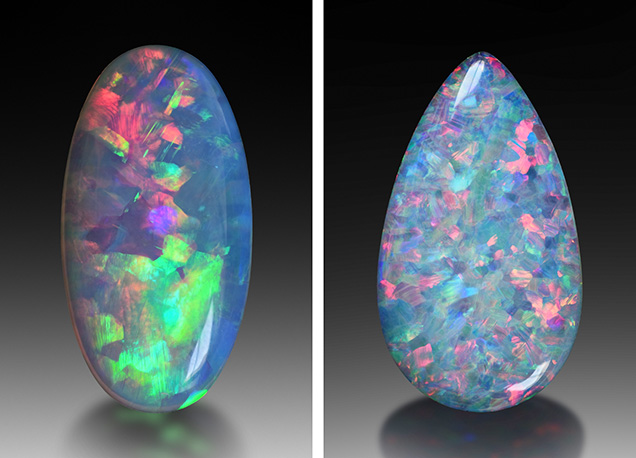
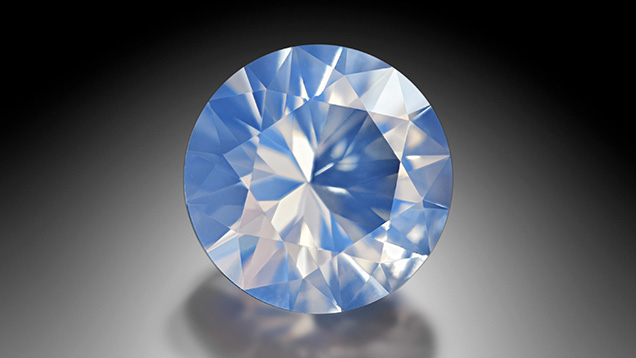

As for the cutting, Kromka explained that Great Rent JSC chooses skilled cutters who specialize in opal to maximize the recovery from each stone. Precious opals are mostly cut as cabochons (figure 17), while gem-quality glassy opal (i.e., Slovak Ice Opal) is usually faceted (figure 18). After cutting, every opal piece receives a unique identifier and is registered in a custom-developed software that is also used to generate gem certificates. Kromka graciously provided recent data on the processing of Slovak Opal and Slovak Ice Opal (table 4). Since the table shows statistics for both rough and cut material, it is possible to calculate cut yields ranging from 18.23% to 26.22%. The minimum and maximum opal weights provided are also interesting because they indicate the size of gemstones available for sale.
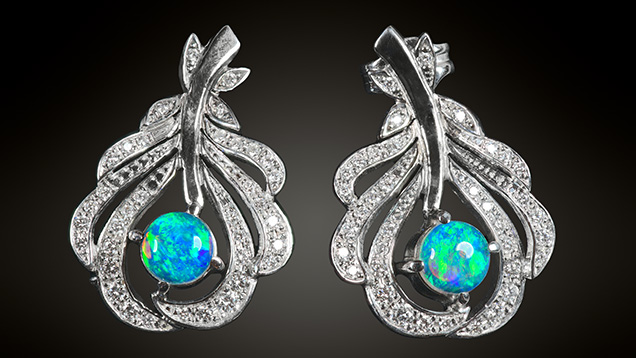

Once an opal cut is finalized, it is put either in inventory or directly into the production process and crafted into jewelry, Kromka noted. Each product commissioned by Great Rent JSC or a client of the company is unique (figures 19 and 20). In addition to selling jewelry and excluding mineralogical specimens, Great Rent JSC offers three services:
1. Selling a rough opal piece accompanied by a certificate. The client decides how to use the opal, and Great Rent JSC assumes no further responsibility.
2. Selling a rough opal piece with options for either cutting alone or cutting and crafting into jewelry. In these situations, Great Rent supervises the process and issues a certificate upon completion.
3. Selling a cut opal with a certificate.
Great Rent JSC prefers doing business face-to-face with customers. The company provides a venue (either their own sales events or participation in others’ events), or they can visit the client if preferred. According to the most recent information provided, the company is developing an e-commerce platform.
SUSTAINABLE MODEL
Bringing a historical gem back to life is no easy feat. Today, the Červenica-Dubník locality certainly cannot supply the market with opal on a large scale. There are, however, some advantages that the stakeholders can capitalize on. In particular, the Červenica-Dubník locality is very likely the world’s oldest known commercial source of precious opal, with a long, rich history. Even its apparent disadvantages of limited access to reserves and a yield of mostly small cut stones could be an asset due to scarcity driving up demand and price. The market has plenty of opal and large cut opal from various sources, but some consumers will want to possess a Slovakian stone.
During the author’s interview with Turek and Kromka, the two directors described their business model. Collaboration between Slovenské opálové bane Ltd and Great Rent JSC is rational and mutually beneficial. By focusing on specific activities rather than operating individually across a broad spectrum, the two companies are able to deliver high-quality results. The former manages on-site activities, such as conventional medium-size group tours or more adventurous small-group tours that include opal hunting and occasional collecting of opal for sale. The latter company handles off-site operations such as processing, jewelry making, and sales, tasks that require expertise and mobility.
Both parties share a common goal. By supporting each other in various ways, they seek to revive the historical gem under a new name, Slovak Opal, while preserving and developing a unique historical site. The hope is that this cooperation will build on the successful past of this opal source and continue it for as long as possible.



